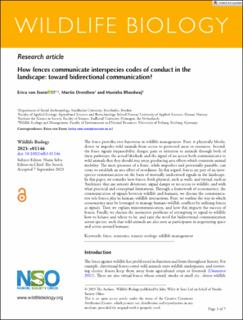How fences communicate interspecies codes of conduct in the landscape: toward bidirectional communication?
Peer reviewed, Journal article
Published version
Permanent lenke
https://hdl.handle.net/11250/3121817Utgivelsesdato
2023Metadata
Vis full innførselSamlinger
Sammendrag
The fence provides two functions in wildlife management. First, it physically blocks, deters or impedes wild animals from access to protected areas or resources. Second, the fence signals impassability, danger, pain or irritation to animals through both of these pathways: the actual blockade and the signal of no access both communicates to wild animals that they should stay away, producing area effects which constrain animal mobility. The mere presence of a fence, while imperfect and potentially passable, can come to establish an area effect of avoidance. In this regard, fences are part of an inter-species communication on the basis of mutually understood signals in the landscape. In this paper, we consider how fences, both physical, such as walls, and virtual, such as ‘biofences’ that use sensory deterrents, signal danger or no access to wildlife, and with what practical and conceptual limitations. Through a framework of ecosemiotics, the communication of signals between wildlife and humans, we discuss the communica-tive role fences play in human–wildlife interactions. First, we outline the way in which ecosemiotics may be leveraged to manage human–wildlife conflicts by utilizing fences as signals. Then we explain miscommunication, and how this impacts the success of fences. Finally, we discuss the normative problems of attempting to signal to wildlife how to behave and where to be, and raise the need for bidirectional communication across species, such that wild animals are also seen as participants in negotiating space and access around humans.

